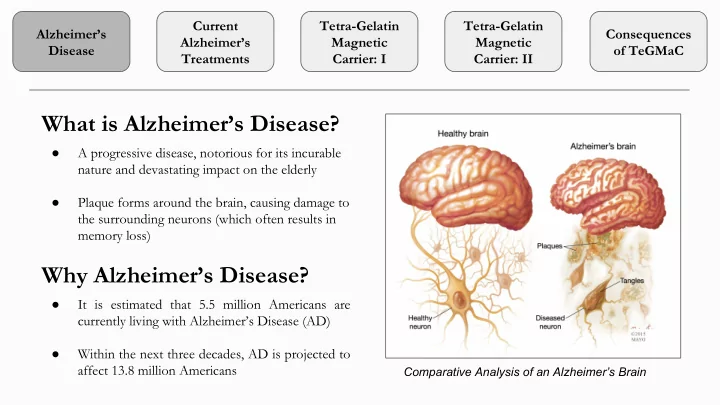

Current Tetra-Gelatin Tetra-Gelatin Alzheimer’s Consequences Alzheimer’s Magnetic Magnetic Disease of TeGMaC Treatments Carrier: I Carrier: II What is Alzheimer’s Disease? ● A progressive disease, notorious for its incurable nature and devastating impact on the elderly ● Plaque forms around the brain, causing damage to the surrounding neurons (which often results in memory loss) Why Alzheimer’s Disease? ● It is estimated that 5.5 million Americans are currently living with Alzheimer’s Disease (AD) ● Within the next three decades, AD is projected to affect 13.8 million Americans Comparative Analysis of an Alzheimer’s Brain
Current Tetra-Gelatin Tetra-Gelatin Alzheimer’s Consequences Alzheimer’s Magnetic Magnetic Disease of TeGMaC Treatments Carrier: I Carrier: II Nanotechnology and Alzheimer’s: ● Used in the early detection of Alzheimer’s disease through the identification of biomarkers in the blood ● Utilized as nanocarriers to deliver therapeutic treatments in a non-invasive and non-toxic manner ● Applied as scaffolds for on-site neural tissue regrowth and surfaces for stem cell culturing Risks and Problems: The Use of Nanotechnology in a Standard Laboratory Setting ● Current nanotechnology does not take into account the Blood Brain Barrier (BBB) and fails to address AD’s specialized nature
Current Tetra-Gelatin Tetra-Gelatin Alzheimer’s Consequences Alzheimer’s Magnetic Magnetic Disease of TeGMaC Treatments Carrier: I Carrier: II Tetra Gelatin Magnetic Carrier (TeGMaC): A Novel Treatment for Alzheimer’s Disease inhibits the progression of tau tangles by using delivers stem cells to the sites Kinase-3β of degenerated neurons where they are differentiated as neurons and transplanted works chemically to remove throughout the brain plaque by using the HEPPS molecules harnesses the properties of magnetism to attract and monitors, records, and sends repel the four gelatin carriers information to a patient’s neurologist regarding TeGMaC’s effectiveness
Current Tetra-Gelatin Tetra-Gelatin Alzheimer’s Consequences Alzheimer’s Magnetic Magnetic Disease of TeGMaC Treatments Carrier: I Carrier: II The Delivery ● In order to pass the blood brain barrier, TeGMaC is administered through the olfactory mucosa which gives it direct access to the brain ● These gelatin nanocarriers, being biocompatible, are able to pass through the olfactory mucosa directly to the central nervous system and dissolve in the bloodstream TeGMaC separates into four individual components to perform their respective functions. The introduction of TeGMaC into the body intranasally, bypassing the blood brain barrier.
Current Tetra-Gelatin Tetra-Gelatin Alzheimer’s Consequences Alzheimer’s Magnetic Magnetic Disease of TeGMaC Treatments Carrier: I Carrier: II Consequences of TeGMaC: ● Can drastically improve the quality and quantity of life for Alzheimer’s patients worldwide ● TeGMaC fails to chemically remove current tau tangles and can only prevent their formation in the future ● TeGMaC may run into complications with the immune system in the form of stem cell rejection ● Adaptable method for applications in other neurodegenerative Civil rights activist, Rosa Parks, suffered from Alzheimer’s Disease. With the diseases and research application of our technology, people ○ Parkinson’s Disease; around the world affected by the same ■ TeGMaC could carry dopamine and stem cells, rather illness as Rosa Parks will be able to live longer and healthier lives, revolutionizing than HEPPs and Kinase-3 the treatment of Alzheimer’s.
Recommend
More recommend